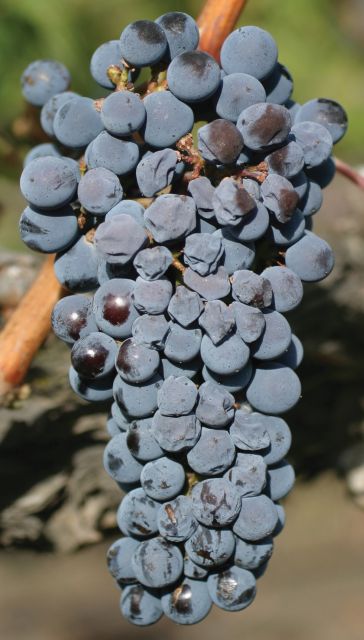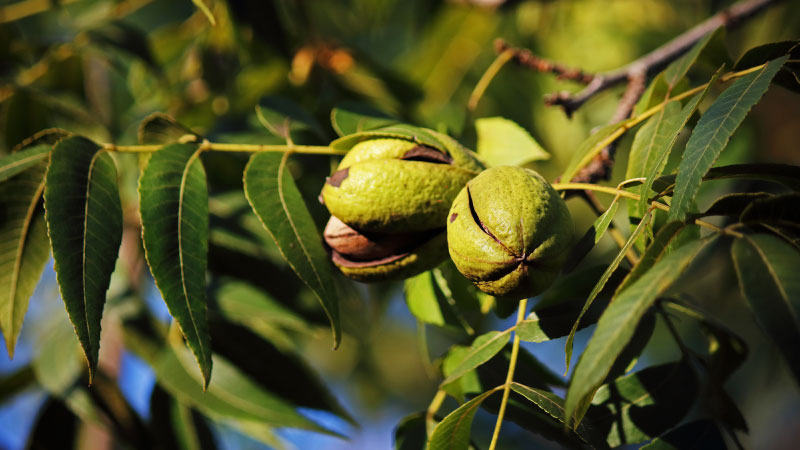How to Handle Warming Pacific Northwestern Vineyards

The poor coloration of these ‘Cabernet Sauvignon’ berries is due to excessive heat. (Photo: Markus Keller)
The recent warming trend and drought conditions, particularly in the Pacific Northwest (PNW), have caused some grape growers to adjust production practice in several areas to remain viable.
Some of those changes include choosing varieties that work well in the warmer climate, producing in the best location in the PNW, implementing conservative irrigation practices, moving away from upright training of shoots, and using wind machines to mitigate the effects of a frost – just to name a few.
Washington State, in particular, is known for the production of grapes for both the wine and grape juice industries. As the temperatures in the state continue to rise, those producing grapes for juice have had an increasingly more difficult time, says Markus Keller, a Professor of Viticulture at Washington State University.
“About half of the juice grapes in the nation are produced in Washington, mostly ‘Concord’ grapes, which are classically cool-climate grapes that don’t ripen well under overly warm conditions,” he explains.
They won’t ripen evenly in warm weather, they’ll have poor color, and they lack sugar, Keller says. Over the long term, he says the juice industry in the PNW is threatened because of the warming trend.
Winegrapes Capitalize on Warm Temps
Winegrapes, however, are a different story. Keller says red winegrape varieties, in particular, are benefiting from the warming temperatures and, as a result, the region is changing from white to red winegrape production. The recent planting trends show growers have doubled acreage in the last 15 years, mostly for winegrapes such as ‘Cabernet Sauvignon,’ he adds.

Markus Keller
Why ‘Cabernets’? Keller says it is because ‘Cabernet Sauvignon’ grapes require a reasonably long, warm growing season to make high-quality wines.
White winegrapes, however, don’t fare as well in the heat and as a result, he says the state is seeing a change in variety mix: more red, less white, and more long-season, warm-climate varieties.
Keller also says he is seeing a trend where vineyards are being planted at somewhat higher elevations further north in the state in areas where vineyards had not been located in the past. He attributes this trend at least partly to the change in climate.
The higher elevations are cooler, which is said to help bring out the fruit flavor in the wine. Keller also says he is seeing more California companies move into Washington. While this might be just a marketing trend, it could also be that parts of the Golden State are becoming too warm to successfully produce premium-quality winegrapes
Drought Decisions
Similar to the situation California growers faced recently, the warming trends coupled with the lack of snowfall in the mountains in recent years led to a water deficit in the summer for irrigation.
Having enough irrigation water in the future is one of the area’s big challenges, Keller says. Fortunately, winegrapes don’t use a lot of water; juice grapes and other crops do.

These sunburned ‘Cabernet Sauvignon’ berries are also suffering from dehydration from water stress. (Photo: Markus Keller)
For this reason, he says there is a potential to see a shift away from those crops to more winegrape production.
On a positive note, Keller says many winegrape growers have adopted deficit irrigation practices. In essence, he says they are timing the water supply.
“Knowing exactly how much water to apply and at what stage of development has become critical,” he explains. “There are some periods where you can drop water supply substantially and have a positive effect on the quality of red winegrapes. There are other periods, however, where you have to water.”
Figuring out this watering strategy has been important, Keller says. “When do winegrapes need water and how much do they need? Contrary to European myths, you should hold water back before, not after, the grapes begin to ripen. You can actually apply more water in the ripening period, which is usually considered the opposite in Europe. That is a big advantage for us. We can get away with using less water when we have drought stress — for red winegrapes.”
Changes in Viticultural Practices
In addition to the change in varieties produced and irrigation practices, Markus Keller, a Professor of Viticulture at Washington State University, notes three other changes winegrape growers in the region are implementing.
A move away from the strict upright training of shoots. Vineyards in the East or in Europe position the shoots vertically upright in between wires, which Keller says is good in a cool climate because there is more sun on the fruit, warming the fruit garnering better color and flavor.
“In our climate now, we have too much sun and heat on the fruit,” he explains. “So we have more of the V-shaped canopy where the shoots hang out a little bit more on either side of the rows, providing some shading on the fruit. To avoid sunburn, you don’t want overexposed fruit. Plus, overheating fruit is not good for color and flavor development.”
More mechanization. This is partly due to labor not being available as well as growers not having to worry about the exact positioning of every leaf and every shoot because it is warm enough anyway, Keller says.
“Positioning each shoot, leaf, and cluster just right to coax the maximum color and flavor out of the berries is much more important in areas with insufficient or inconsistent sunshine and heat,” he continues. “We have plenty of both, so growers can get away with less manual labor.”
Installation of wind machines. More wind machines are being installed that mix the air layers in case of frosts, which are happening more frequently in the spring.
“Overall, we are having milder winters and when it gets cold, the grapes seem to be susceptible to cold injury,” he says. “Growers need to be aware of that and put in protective measures for both winter and spring. We see more wind machines now because more grapes are being planted.”










